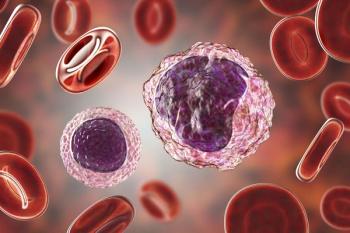
mFOLFIRINOX/S-IROX Does Not Show Superiority to SOC in Pancreatic Cancer
After the predictive probability of achieving superiority with mFOLFIRINOX or S-IROX was less than 1%, the trial was terminated due to futility.
Chemotherapy regimens consisting of modified leucovorin (folinic acid), fluorouracil, irinotecan, and oxaliplatin (mFOLFIRINOX) as well as S-1, irinotecan, and oxaliplatin (S-IROX) both did not exhibit superiority vs nab-paclitaxel and gemcitabine, a standard of care (SOC), in patients with metastatic or recurrent pancreatic cancer, according to findings from the phase 2/3 GENERATE trial (jRCTs031190009) published in the Journal of Clinical Oncology.
After a median duration of follow-up of 10.1 months (IQR, 6.0-17.4) in the intention-to-treat population, the median overall survival (OS) in the nab-paclitaxel/gemcitabine arm was 17.0 months (95% CI, 14.5-18.9) compared with 14.0 months (95% CI, 11.4-16.3) in the mFOLFIRINOX arm and 13.6 months (95% CI, 12.3-16.3) in the S-IROX arm (HR, 1.29; 95% CI, 0.98-1.70). Additionally, an OS benefit with the nab-paclitaxel/gemcitabine showed consistency across prespecified groups.
The median progression-free survival (PFS) in the nab-paclitaxel/gemcitabine, mFOLFIRINOX, and S-IROX arms were 6.7 months (95% CI, 5.7-7.4), 5.8 months (95% CI, 5.1-6.9; HR, 1.15; 95% CI, 0.91-1.45), and 6.7 months (95% CI, 5.7-8.3; 95% CI, HR, 1.07; 95% CI, 0.84-1.35), respectively. Additionally, the objective response rates (ORRs) in the respective arms were 35.4% (95% CI, 28.4%-43.0%), 32.4% (95% CI, 25.4%-39.9%), and 42.4% (95% CI, 34.8%-50.2%).
“GENERATE was unexpectedly terminated early owing to futility in the planned interim analysis. The OS was numerically longer in the nab-paclitaxel/gemcitabine group than in the mFOLFIRINOX and S-IROX groups. On the other hand, PFS was similar among the 3 groups,” the authors of the study wrote. “This study reported an early analysis of a short observation period, but the results showed that the HR for PFS of mFOLFIRINOX compared with nab-paclitaxel [plus] gemcitabine was 1.39 (95% CI, 0.95-2.03) and the HR for OS was 1.66 (95% CI, 1.10-2.49), indicating that nab-paclitaxel [plus] gemcitabine might have better results.”
The multicenter, open-label trial enrolled patients 20 to 75 years old with histologically or cytologically confirmed metastatic or recurrent pancreatic ductal adenocarcinoma (PDAC) or nonsquamous carcinoma not previously treated and randomly assigned them 1:1:1 to receive nab-paclitaxel plus gemcitabine (n = 176), mFOLFIRINOX (n = 175), or S-IROX (n = 176). Patients in the nab-paclitaxel/gemcitabine arm received 125 mg/m2 of nab-paclitaxel and 1000 mg/m2 of gemcitabine on days 1, 8, and 15 every 4 weeks.
In the mFOLFIRINOX arm, treatment consisted of oxaliplatin at 85 mg/m2 over 2 hours, irinotecan at 150 mg/m2 over 90 minutes, leucovorin at 200 mg/m2 over 2 hours, each once daily on day 1, as well as fluorouracil at 2400 mg/m2 over 46 hours on days 1 to 3 of each 2-week cycle. Additionally, S-IROX consisted of oxaliplatin at 85 mg/m2 over 2 hours and irinotecan 150mg/m2 over 90 minutes on day 1, as well as S-1 at 80 mg/m2 orally twice daily on days 1 to 7 of each 2-week cycle.
Across the nab-paclitaxel/gemcitabine, mFOLFIRINOX, and S-IROX arms, respectively, the median age was 65 years (IQR, 57-70), 67 years (IQR, 59-71), and 65 years (IQR, 57-70). A total of 49.4%, 59.4%, and 63.6% of patients were male; 67.0%, 67.4%, and 67.6% had an ECOG performance status of 0; 97.2%, 97.7%, and 98.3% had adenocarcinoma histology; and 93.8%, 95.4%, and 94.9% had metastatic disease. Furthermore, 65.9%, 58.9%, and 61.9% had 1 metastatic site; 66.5%, 70.9%, and 70.5% had liver metastases; 61.4%, 61.1%, and 60.2% had tumors located in the body or tail of the pancreas; and 81.2%, 77.7%, and 84.1% had a baseline CA 19-9 level of 37 U/mL or greater.
The primary end point of the phase 2 portion of the trial was ORR in the S-IROX group, and in the phase 3 portion, it was OS in all randomly assigned patients. Secondary end points included PFS, ORR by investigator review, safety, and dose intensity.
Regarding safety, grade 3 or 4 neutropenia was observed more frequently with nab-paclitaxel (60.3%) than with mFOLFIRINOX (51.5%) or S-IROX (38.7%). Additionally, grade 3 or 4 anorexia was observed in 5.2%, 22.8%, and 27.6% of the respective groups, with grade 3 or 4 diarrhea reported in 1.1%, 8.8%, and 23.0%. Furthermore, only 1 treatment-related death occurred in the S-IROX group.
Reference
Ohba A, Ozaka M, Mizusawa J, et al. Modified fluorouracil, leucovorin, irinotecan, and oxaliplatin or S-1, irinotecan, and oxaliplatin versus nab-paclitaxel + gemcitabine in metastatic or recurrent pancreatic cancer (GENERATE, JCOG1611): a randomized, open-label, phase II/III trial. J Clin Oncol. Published online July 28, 2025. doi:10.1200/JCO.24.00936
Newsletter
Stay up to date on recent advances in the multidisciplinary approach to cancer.
































































































